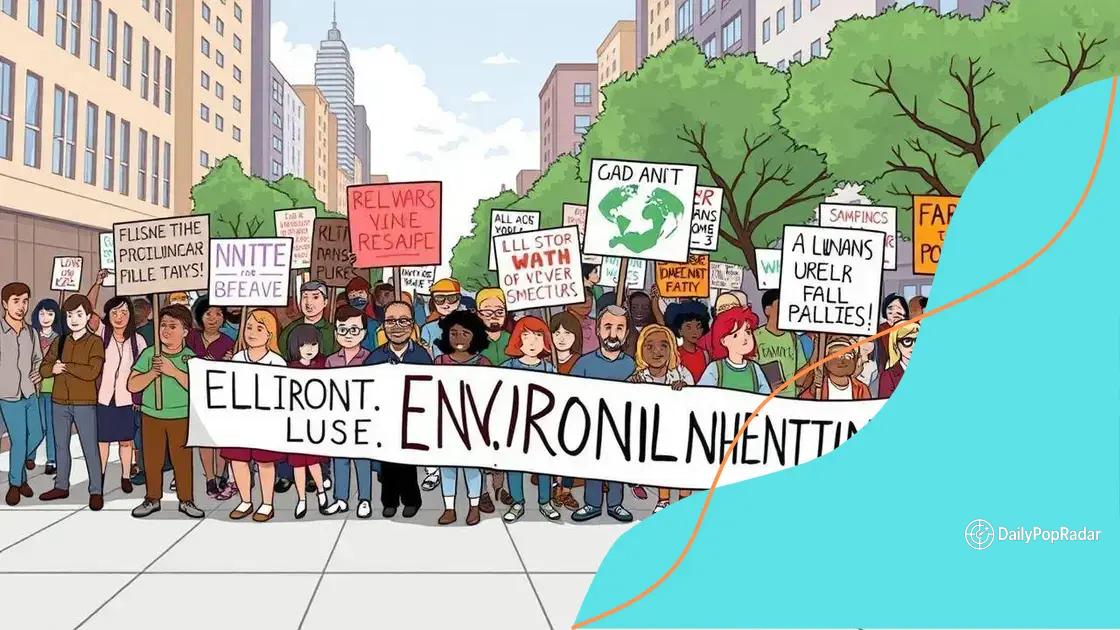Green policies face political resistance: what’s next?

Green policies face political resistance primarily due to economic concerns, industry influence, and lack of public awareness, making collaboration among stakeholders essential to drive effective legislative change.
Green policies face political resistance, often hindering progress towards sustainability. Have you ever wondered what drives this opposition and how it affects our environment? Let’s delve into the complexities of this issue.
Understanding political resistance to green policies
Understanding political resistance to green policies is essential in today’s world. Many initiatives aimed at protecting our environment and promoting sustainability face challenges from various political sectors. Recognizing the root causes of this resistance helps us find solutions.
One significant factor is the economic implications associated with green policies. Some politicians fear that these initiatives could lead to job losses in traditional industries. Additionally, there are concerns about the costs involved in transitioning to renewable energy sources.
Key reasons for political resistance
There are several reasons why certain groups resist green policies:
- Economic impact: Fears of increased taxes or economic downturns.
- Industry influence: Strong lobbying from industries that might be negatively impacted.
- Political agendas: Some politicians push for policies that align more with their agendas than with sustainability.
- Lack of public awareness: Limited understanding of the benefits of green policies can lead to reluctance.
The intersection of these elements creates a complex situation where politicians sometimes prioritize short-term gain over long-term well-being. For example, when discussing clean energy initiative funding, opponents may highlight potential job losses rather than the environmental benefits and new job opportunities that could arise.
Moreover, cultural values and local beliefs can play a significant role in shaping perspectives on environmental issues. In some regions, strong ties to traditional energy sources can create a resistance to change. Recognizing these cultural dynamics allows advocates to tailor their messaging more effectively, making it more relatable and convincing.
As we navigate this landscape, understanding the political resistance to green policies is crucial for anyone looking to promote environmental change. Engaging in open dialogues, educating the public, and emphasizing the long-term benefits can help bridge the gap between policy-makers and the advocates for sustainability.
Key factors influencing opposition to eco-friendly initiatives
Several key factors influence the opposition to eco-friendly initiatives. Understanding these factors can help advocates develop strategies to overcome resistance. Awareness of what drives this opposition is essential for creating effective environmental policies.
Economic Concerns
Many people worry about the economic impact of green initiatives. They often fear that such policies will result in job losses, especially in industries reliant on fossil fuels. These fears can lead to significant pushback against eco-friendly measures.
- Job security: Employees may fear losing their jobs as industries transition to greener alternatives.
- Cost of implementation: There can be concerns about the upfront costs of adopting new technologies.
- Tax implications: Many see environmental taxes as burdensome and believe they will increase financial strain.
Beyond economic fears, social factors play a significant role. People’s values and beliefs can shape their views on environmental issues. In some communities, strong ties to traditional practices lead to resistance against change.
Political Influence
The political landscape also greatly affects public perception of eco-friendly initiatives. Politicians and lobbyists with vested interests may spread misinformation to sway public opinion. This type of discourse can create a climate of distrust regarding substantial green policy changes.
Additionally, public awareness is crucial. If people are not well-informed about the benefits of these initiatives, they might reject them outright. Education and outreach are necessary to help mitigate these issues. Advocates must strive to turn skepticism into understanding and support.
By addressing economic and social concerns while navigating the political landscape, those involved in pushing for eco-friendly initiatives can create stronger coalitions and work toward positive change.
Case studies: Successful green policies despite resistance

Many successful green policies have emerged despite significant resistance. These case studies demonstrate how effective strategies can lead to impactful environmental change. By examining these successes, we can uncover methods that may work in other contexts.
Renewable Energy Initiatives
One notable example is the transition to renewable energy in Germany. Despite initial pushback, the country became a leader in solar and wind energy. The Feed-in Tariff program incentivized energy production from renewable sources, significantly increasing adoption levels.
- Job creation: The renewable sector created hundreds of thousands of jobs.
- Public support: Education and awareness efforts helped gain public backing.
- Investment incentives: Government investment stimulated growth in clean technologies.
Similarly, Costa Rica is a prime example of implementing successful national policies favoring sustainability. The country generates over 99% of its electricity from renewable sources. This achievement is the result of a long-term commitment to environmental conservation and innovative policies.
Urban Green Spaces
Urban areas have also seen success in creating green spaces. Cities like New York have transformed park initiatives into vibrant community assets. Resistance from local businesses and residents was addressed through community engagement, showcasing how parks can improve quality of life.
Initiatives such as community gardens and green roofs have flourished despite early opposition. These projects highlighted:
- Health benefits: Access to green spaces leads to improved mental health.
- Community involvement: Residents who participate see tangible benefits.
- Environmental impact: Increased biodiversity in urban settings promotes ecosystems.
By studying these successes, advocates for green policies can learn valuable lessons. Collaboration, education, and addressing economic concerns are vital for overcoming opposition and driving forward effective environmental legislation.
Collaboration between stakeholders for effective change
Collaboration between stakeholders is essential for achieving effective change in green policies. When various groups work together, they can overcome challenges and create more impactful solutions. This partnership often leads to better understanding and implementation of eco-friendly initiatives.
Key Stakeholders Involved
Several stakeholders play a crucial role in promoting sustainability. These include government agencies, non-profit organizations, businesses, and the public. Each group brings unique perspectives and resources to the table, making collaboration vital for success.
- Government agencies: They create and enforce regulations that support green initiatives.
- Non-profit organizations: These groups provide advocacy and community engagement to raise awareness of environmental issues.
- Businesses: Companies can invest in sustainable practices and technologies that benefit the environment.
- The public: Community support and participation drive successful environmental policies.
Working together, these groups can develop comprehensive strategies. For example, the formation of public-private partnerships can lead to innovative funding solutions for sustainable projects. This collaboration ensures that different segments of society are involved in decision-making, creating a sense of ownership among stakeholders.
Benefits of Collaboration
Collaboration increases the chances of success for green policies. By pooling resources and expertise, stakeholders can tackle more complex environmental issues effectively. Another benefit is the opportunity for knowledge sharing. When stakeholders communicate openly, they can learn from one another’s experiences and apply best practices.
Engaging in collaboration also fosters public trust. People are more likely to support initiatives when they see transparent efforts involving various parties. As a result, collaborative efforts build stronger community support for sustainability, paving the way for long-term change.
The role of public opinion in shaping environmental legislation
The role of public opinion is crucial in shaping environmental legislation. When people express their views about environmental issues, lawmakers often take notice. Public support or opposition can significantly influence the direction of policies aimed at protecting the environment.
Influencing Factors
Several factors influence public opinion on environmental matters. Awareness about climate change and eco-friendly practices can drive people to advocate for stronger legislation. Additionally, media coverage plays a vital role in shaping perceptions. When issues receive extensive coverage, public interest tends to grow.
- Education: Better understanding of ecological issues leads to increased support for green policies.
- Media representation: News reports can either highlight the urgency of environmental problems or downplay them.
- Community initiatives: Local projects can mobilize support and inspire action in the wider community.
As public concern for environmental issues grows, politicians often feel pressure to respond. Many lawmakers align their agendas with the priorities of their constituents. This connection between public sentiment and political action can lead to the passage of significant environmental laws.
Case Studies
There are numerous case studies illustrating how public opinion has shaped environmental legislation. For instance, movements advocating for renewable energy have gained traction, resulting in supportive policies. Grassroots campaigns often provide the momentum needed to initiate change.
In many cases, environmental advocacy groups leverage public opinion to push for reforms. By organizing protests, petitions, and awareness campaigns, they can engage the community and encourage policymakers to take action. The collective voice of concerned citizens can lead to meaningful legislative changes that align with public desires.
Understanding the influence of public opinion is essential for anyone involved in environmental advocacy. It shows that every voice matters and that collective efforts are powerful tools in driving legislative change.
In summary, the journey toward effective environmental policies hinges on understanding the multifaceted dynamics at play. Collaboration among stakeholders, the influence of public opinion, and the advocacy efforts of grassroots movements all play a vital role in shaping legislation. By learning from successful case studies, we can find inspiration and strategies that lead to meaningful change. Together, we can overcome resistance and work towards a sustainable future for everyone.
FAQ – Frequently Asked Questions About Green Policies and Public Opinion
How does public opinion influence environmental legislation?
Public opinion plays a crucial role by encouraging lawmakers to consider the views and needs of their constituents when crafting policies.
What are some successful examples of green policies?
Examples include Germany’s renewable energy initiatives and Costa Rica’s commitment to 99% renewable electricity generation.
How can stakeholders collaborate to promote sustainability?
Stakeholders can work together through partnerships, sharing resources, knowledge, and advocacy efforts to drive change more effectively.
What role do grassroots movements play in environmental change?
Grassroots movements mobilize community support and raise awareness, often leading to significant public backing for environmental policies.
